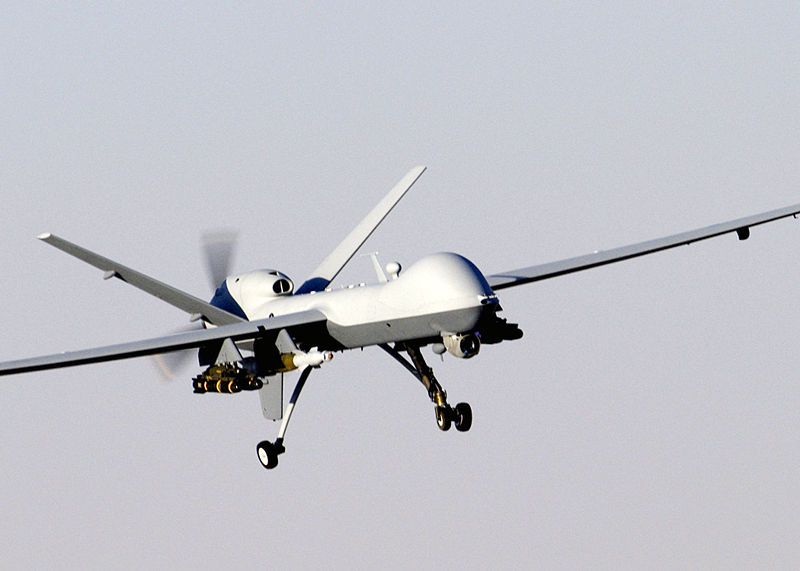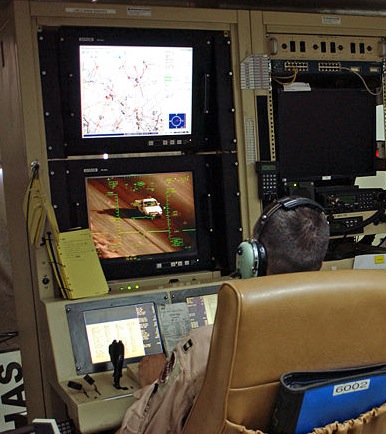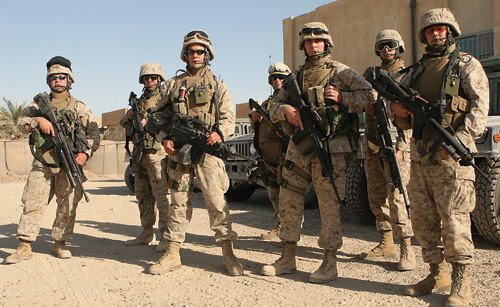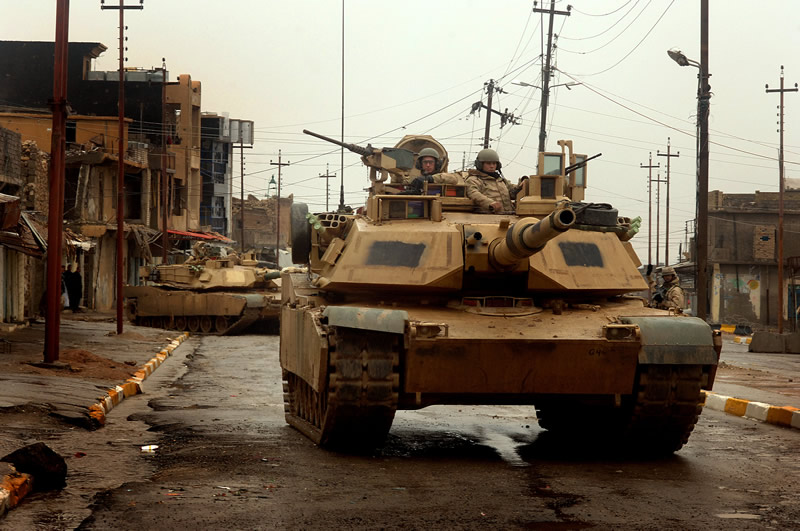A couple of recent events, globally and personally, got me applying wither to war and to the role of the rifleman, the guy with the gun, the man on the front lines. They got me thinking on this topic not in a "build a world beyond war" sort of sense -- I'm much too practical and cynical to believe that conflict, armed or otherwise, will ever cease between people, peoples, and nations. And I appreciate the value of a strong and solid defense, that much is for sure. Instead my musings were (and still are) in an operational sense -- given the current and projected future political and economic climate in the world, what sort of conflicts are likely and what sort of roles should we expect our military to play in them? And, taking it to the next and (personally) more interesting derivative, how do we organize and equip our military to respond to those challenges?
 The first thing that got these musings started was an article in Aviation Week that a USAF Reaper UAV (drone, if you're not down with the aerospace lingo) dropped a bomb on an explosive carrying remote controlled car in Iraq. The first thought, based on the remote controlled car thing, was of the two brothers from the cast of Ocean's Eleven. But then the story percolated and the true point of it hit: one robot attacked another.
The first thing that got these musings started was an article in Aviation Week that a USAF Reaper UAV (drone, if you're not down with the aerospace lingo) dropped a bomb on an explosive carrying remote controlled car in Iraq. The first thought, based on the remote controlled car thing, was of the two brothers from the cast of Ocean's Eleven. But then the story percolated and the true point of it hit: one robot attacked another.Now let's be far and stop preparing for the Rise of the Machines. Both vehicles were remote controlled -- that's a far cry from SkyNet and the Terminators. A crew, probably in Langley Virginia, was controlling the Reaper via a satellite link and another crew, probably standing by the side of the road, was controlling the bombed-up Iraqi SUV. Come to think of it, this has got nothing at all on Battlebots. Well, except for the fact that the one remote control robot thingy was trying to kill people and the other remote control robot thingy was linked via satellite to a station half way around the world and dropped a 500lb laser guided bomb on the first remote control robot thingy.
 Never the less, this illustrates one of the projected directions of modern air war. Un-crewed (we don't say "unmanned" any more) air vehicles have the wonderful ability to stay on scene for hours and hours and hours -- days even. A Reaper can loiter for NN hours, a Global Hawk for 40 to 48, and that latter figure after flying a 3,000nm round trip from home field to target area. This kind of sustained presence is invaluable in brining the areal perspective to the kind of fight going on in Iraq and Afghanistan. The traditional fast mover can offer little but responsive firepower -- heading in from a loitering point when called for by guys on the ground and depending on them for direction and guidance. Even maintaining that kind of ability -- a "cab rank" of close air support -- requires a couple of dozen aircraft in the field, tankers, and a rotating (and expensive) presence.
Never the less, this illustrates one of the projected directions of modern air war. Un-crewed (we don't say "unmanned" any more) air vehicles have the wonderful ability to stay on scene for hours and hours and hours -- days even. A Reaper can loiter for NN hours, a Global Hawk for 40 to 48, and that latter figure after flying a 3,000nm round trip from home field to target area. This kind of sustained presence is invaluable in brining the areal perspective to the kind of fight going on in Iraq and Afghanistan. The traditional fast mover can offer little but responsive firepower -- heading in from a loitering point when called for by guys on the ground and depending on them for direction and guidance. Even maintaining that kind of ability -- a "cab rank" of close air support -- requires a couple of dozen aircraft in the field, tankers, and a rotating (and expensive) presence.Given the proliferation of MANPADS (MAN Portable Air Defense Systems -- here it is OK to be sexist and assume the shooter is a guy) there is also a vast risk in having a two of four ship of F-16's hanging around in the skies near target-land, even if the airspace is nominally under friendly control. This is particularly true when the airspace is more heavily defended, less nominally under friendly control, or is airspace that isn't supposed to have any of our guys operating over it in the first place.
Right now, the use of UAV's as a surveillance and targeting tool (robot vs. robot or robot vs. human) is confined to the tactical -- to supporting troops on the ground, watching convoy routes, and patrolling cities looking for characteristic acts of bad-guy behavior. The weapons employed have typically been in the "lightweight" category: Hellfires and 500lb bombs and a lot of attention is going to even lighter weight weapons like the very clever Viper Strike to enable close-in drops.
But many analysts (including myself) see a future where persistent uncrewed surveillance and targeting assets mix with stand-of missiles to combine near-real-time covert operation with the sort of hard-hitting punch traditionally associated with manned aircraft and, in particular, strategic assets. Which is talk-around speak for B-52's, B-1B's, and B-2's. Granted, a single B-2 can drop something like 16 2,000lb bombs -- and it'll take a lot of missiles to equal that kind of warload. And I'm not going to get into the economic argument of 1 B-2 bomber vs. 200 Tomahawks or such -- because that sort of argument will go back and forth until the cows come home since the numbers inevitably involve a considerable amount of speculation and how-much-a-human-life and where-do-you-draw-the-line logic (which allows them to be tweaked to say whatever you want them to...).
And that's not the point of this blog entry, either. The point -- or at least a stepping stone -- is that I see air combat increasingly the domain of the uncrewed vehicle. Some roles will remain crewed: big assets (bombers), for example, will long continue to have people in them -- putting someone inside an asset of that power (and expense) creates a warm fuzzy feeling of control and responsibility. But you get the point.
The second thing that got me musing on this particular path was the long-delayed fruition of some Internet research. Sometimes things on that fabulously interconnected collection of information go that way: you start looking for something, fail to find it, give up, and three months later find it purely by accident. Perhaps it got posted while you weren't looking. Perhaps someone else found it and put a link someplace you just happened to be looking. Perhaps you subtly shifted your Google search terms just enough to get the right result this time. Anyway, because of this phenomena, I sometimes go back and start tossing out a few searches for questions I'd been trying to answer but had to give up on.
A couple of weeks ago one of these bore fruit. I've long had a fascination with military organizations -- the structuring of military forces to cope with the expected (and unexpected) trials and tribulations of deployment and combat. It is an optimization puzzle -- given a constrained number of people (and money and other assets), how do you best arrange things to bring effective, robust, and sustainable combat power to bear? Philosophies on these organizations shift about every decade or so as the conflicts underway in the world shift from one sort to another. As the NATO armies began to see their roles changing from that of a Cold War roadblock against the Soviet Union to that of flexible, transportable intervention forces, they had to do some hard re-examination of force structures. As the U.S. Army increasingly found itself fighting a long-lasting counterinsurgency as opposed to a fast-moving war of maneuver, it had to do some equally dramatic re-examination of force structures.
As you can imagine, this is a big time of self-examination for the world's armies. Those not directly involved in a fight somewhere are watching and learning lessons and trying to forecast the next fight and therefore, the next round of organization and equipment. So a lot of armed forces are going through periods of structural change -- and change is always disturbing for the changee but interesting and illuminating for the observer. Different organizational approaches and different concepts of restructuring can reveal a lot about the underlying philosophies of the force in question and the operational history through which it has evolved.
This isn't an examination of different TOE organizations or what they mean about the culture of a nation or a military. Suffice it to say that I was having fun looking some over. The unavoidable realization is the continued presence of infantry. Tanks have grown from odd curiosities through charging Blitzkrieg cavalry to indispensable support weapons. Missiles, machine guns, and mortars have expanded to populate units ever more thoroughly and diversely at the squad, platoon, company, battalion, and brigade levels. But there at the heart of it remains a collection of guys with rifles.
 Only the guy-with-rifle can clear a stairwell without blowing up the building. Only the guy-with-rifle can rifle through the papers in a bomb-maker's hide looking for contacts. Only the guy-with-rifle can snap interconnected zip-ties across someone's wrists and send him back across the lines. Only the guy-with-rifle can man a roadblock or walk the streets on a dismounted patrol. Only the guy-with-rifle can use his wits and his skill in their purest form to go, see, and report with an intimacy with which no sensor package can compete. And, in the nicer side of the military, only the man-with-rifle can put down that gun and unload supplies or build schools or clear rubble or help the wounded or any of those humanitarian moments.
Only the guy-with-rifle can clear a stairwell without blowing up the building. Only the guy-with-rifle can rifle through the papers in a bomb-maker's hide looking for contacts. Only the guy-with-rifle can snap interconnected zip-ties across someone's wrists and send him back across the lines. Only the guy-with-rifle can man a roadblock or walk the streets on a dismounted patrol. Only the guy-with-rifle can use his wits and his skill in their purest form to go, see, and report with an intimacy with which no sensor package can compete. And, in the nicer side of the military, only the man-with-rifle can put down that gun and unload supplies or build schools or clear rubble or help the wounded or any of those humanitarian moments.Only he possesses that unique flexibility and adaptability of the human.
 Any given guy-with-rifle might now carry a personal radio and GPS receiver, a laser rangefinder, night vision gear, and a short range guided missile -- all gear inconceivable as personal equipment even twenty years ago. His rifle might have a laser spot projector for nighttime target marking, a flashlight, a grenade launcher, and a 4-power scope clamped and strapped to it. He may wear protective gear offering protection unheard of to previous generations of soldiers. But all of this goes to underscore not his budding obsolescence at the hands of impending robotic marvels but rather continued -- or even increased -- importance.
Any given guy-with-rifle might now carry a personal radio and GPS receiver, a laser rangefinder, night vision gear, and a short range guided missile -- all gear inconceivable as personal equipment even twenty years ago. His rifle might have a laser spot projector for nighttime target marking, a flashlight, a grenade launcher, and a 4-power scope clamped and strapped to it. He may wear protective gear offering protection unheard of to previous generations of soldiers. But all of this goes to underscore not his budding obsolescence at the hands of impending robotic marvels but rather continued -- or even increased -- importance.All these marvels have served to distribute the fight in ways never before imagined, each rifle team's scope of responsibility filling an ever larger circle of geography and threat. And as the infantryman finds himself lugging ever more equipment to confront ever more diverse threats, he is again forming the heart of the world's armed forces.
Reviewing the new organizational structures -- either in place or in the works -- all show a shift in the expected focus of the fight from the rolling armored warfare of a NATO vs. Warsaw Pact fight or Operation Desert Storm style towards a tighter grinding battle more akin to what was seen in Bosnia or Iraq. The expected degree (and nature) of cooperation between those long time rivals of the ground fight, the tanks and the infantry, is an interesting thread to follow in trying to understand these shifts.
These military organizations that are heading into the second decade of the 21st century each show some degree of revision in the thinking about how these arms should cooperate. You don't have to be a military analyst to see how awkward a tank can be moving down a city street and yet how devastating a single shot from a 120mm main gun is when confronted with a sandbagged machine gun post that could hold a company of infantry off for hours. And so the armies of the world progressively push the armor-infantry cooperation ever further down the chain of command.
The rifle platoon has long been the sacrosanct heart of the United States Marines, and that particular force cross-attaches so vigorously that a platoon commander could well find himself with tanks, armored transport, heavy machine guns, ATGMs, snipers, or mortars seconded to his direct control. Nothing here is changing -- conditioned by the intimate island fighting of the Pacific, the Marines have never lost sight of their vision as a rifleman-centered force. Tank and Amtrak battalions have always expected (and trained) to be carved up and subordinated to other units for employment in battle. This particular willingness to play mix-and-match with forces from widely separated branches of the force has long been a uniquely Marine style of operation. Coming from the mindset of an intervention force, rather than an anti-Warsaw-Pact roadblock, they have long fostered creativity and versatility. And, it almost goes without saying, a foundation based on the small unit of riflemen.
The new "square" organization and increasingly "combined arms" structure of the US Army's Armored Brigades shows a clear migration towards a infantry-armor balance. In the brigade, two identical combined arms battalions each contain two tank companies and two mechanized infantry companies. The US Army has never regularly brought the combined arms of armor and infantry together in a unit as small as a battalion before (excepting cavalry organizations, by the way). The two-by-two structure also displays an expectation of the tank and infantry forces as a fighting team, mutually supporting each other to deal with urban obstacles, enemy fighting vehicles, close-in threats, and the maneuver fight.
The French army's new structure looks positively gothic and incomprehensible -- and trust me, I've spent plenty of time trying to wrap my thoughts around it. In addition to a smorgasbord of tactical options at every level, it showcases a unique in-between regimental structure for the Leclerc tank force. Thin on support and supporting arms at the upper level, this structure seems to push reconnaisance, fire support, and combined arms down to the company level in a way that defies understanding. Until, that is, the armored regiment is viewed alongside the two infantry battalions that join it to make up a French battalion (I told you it was almost incomprehensible!). Then the thin-at-the-top, heavy-at-the-bottom structure makes sense. The tank regiment itself is a skeleton force that exists only for training and administrative purposes (plus the rare open-field engagement, one could suppose). When deployed, it would be expected to disperse under the operational control of the two rifle battalions, taking its decentralized supply and maintenance resources with it.
Even the Germans, long a panzer-centric force of armored mobility, are starting to change. The Heeresstrukturs of old emphasized infantry as a supporting arm, screening for the armored spearheads, holding territory after an advance, playing at ambush in withdrawal. But now, increasingly aware of NATO's role as a stabilizing and intervention force, the Bundeswehr is fattening its rifle platoons from a scarecly usable eighteen dismounted troops to an at least marginally effective twenty four. Tank and rifle companies now follow exactly identical structures, intended at least partially to enable routine cross attachment down to the platoon level. The equipping of a significant percentage of their fabulous Leopard 2 tanks with dozer attachment further leads to an expectation that the armored arm would accompany the infantry as an integrated anti-obstacle force. Furthermore, the latest couple of iterations of German army structure (going back to the 1990's) have shifted from the three-tank platoon in their armored units to the four tank platoon. The former has been found optimum for use in tank-on-tank engagements (particularly in open terrain). The latter, incidentally long used by both the US Army and Marines) is much better in a supporting role or urban fight -- the four tanks split into two pairs and can continue to provide mutual support where a three tank unit would either be overkill and hingly cumbersome or leave one orphan tank off (and highly vulnerable) on its own.
 All of this makes one thing clear -- the rifleman is here to stay. The reasons for this emphasis shift are obvious -- increasing expectation of urban fighting, prevalance of counter-insurgency fighting, peacekeeping operations where forces work close to the civilian populations rather than in an open field battle -- are obvious and clear to anyone who watches the news. Tanks are retreating from their role as the unstoppable bohemouth's of the battlefield back to the role of supplying escort, protection, and covering fire for the infantry for which they were originally concieved. Air power is threatening to obsolete itself, metamorphosing (at least partially) from resplendant knights of the air into remote control spotters sitting in air-conditioned control vans thousands of miles from conflict.
All of this makes one thing clear -- the rifleman is here to stay. The reasons for this emphasis shift are obvious -- increasing expectation of urban fighting, prevalance of counter-insurgency fighting, peacekeeping operations where forces work close to the civilian populations rather than in an open field battle -- are obvious and clear to anyone who watches the news. Tanks are retreating from their role as the unstoppable bohemouth's of the battlefield back to the role of supplying escort, protection, and covering fire for the infantry for which they were originally concieved. Air power is threatening to obsolete itself, metamorphosing (at least partially) from resplendant knights of the air into remote control spotters sitting in air-conditioned control vans thousands of miles from conflict.And through all of it, the most intimate core of combat remains.
Two quotes. One is a half-remembered paraphrase from (I believe) a former commandant of the US Marines. The other is from Mick Jagger. Go figure.
The most powerful force on the battlefield is a single man with a rifle.
Say a prayer for the common foot soldier.
No comments:
Post a Comment